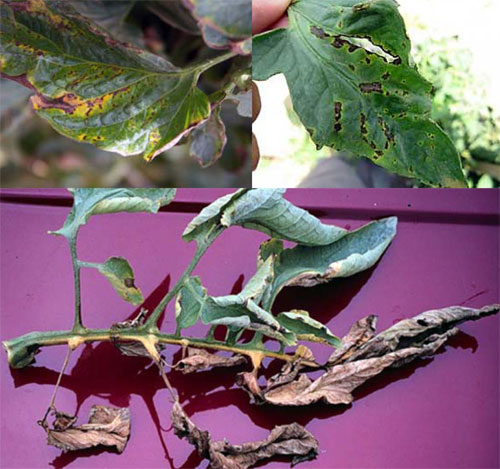2011 was a great year for bacteria in vegetable crops
Why were bacterial diseases on tomatoes severe in 2011? Can I expect the same in 2012? Is there something I need to do to be sure it doesn’t happen again? These are all valid questions that need answers as tomato growers get ready for the 2012 season.
Bacterial diseases on tomatoes and other susceptible vegetable crops are annual problems in Michigan but they seem to be especially bad every couple years. Such was the case in 2011. Under the right conditions, and with adequate inoculum, bacterial diseases spread rapidly within and between fields. Understanding how bacteria propagates and spreads is helpful in minimizing damage. For a review, see Ohio State University’s fact sheet, Bacterial spot, speck and canker of tomatoes. Also go to the lab website of MSU’s Mary Hausbeck for excellent Michigan-based research information. Interested growers are encouraged to visit these websites for a more thorough treatment of these diseases.
Common bacterial diseases on tomatoes are bacterial spot, speck and canker (Figure 1). All three can be seed borne, so the initial step is to buy seed treated for these problems.

Figure 1. Foliar symptoms of bacterial spot (upper left),
bacterial speck (upper right) and bacterial canker (lower). Photo credits: D. Egel and M. Hausbeck.
Greenhouse control is important since plant populations and humidity are high and bacteria move with water splash. Control is critical at this stage since once the plant acquires the disease it carries it the rest of its life and more effective products can be used in the greenhouse. Previous recent articles emphasized greenhouse control, this article deals with field issues.
Bacterial diseases overwinter in the soil on plant debris and on stakes. The first step for field control is good crop rotation, waiting three years between tomato crops to give plant debris an opportunity to decompose. Other steps are to disinfect used stakes, deep plowing to cover plant debris, using plastic or other mulch to place a barrier between the soil and the plant and drip irrigation rather than overhead.
Bacterial colonies can be present on symptomless plants so assume every plant is infected and needs to be quickly planted and covered with a protective copper application. This minimizes plant-to-plant spread and reduces humidity around the plant. This was a main contributor to the 2011 problem. Weather in many areas was not conducive for planting and plants were held two weeks or more in transplant trays. Wet, cool conditions continued through June followed by wet, warm conditions in July making the problem worse. Many rains during this time were hard, driving and accompanied by strong winds. So, late planting, winds, rains and high humidity for two months all contributed to make 2011 a good year for bacterial spread within and between fields.
Currently there are few tomato varieties with good tolerance to bacterial diseases (see alist from Cornell University). Field control is limited primarily to copper products, which should be applied every five to seven days when conditions are conducive for spread. Managing bacterial diseases starts early and continues through harvest. The next step after planting should be a protective copper application. Keeping inoculum low and under control is important for checking disease spread. Even with regular applications, bacterial diseases can get out of control given proper weather conditions.
Will you have the same level of infection in 2012? That depends on several aspects: inoculum on the seed and in the field, what happens in the greenhouse, what happens prior to field planting, the weather and how soon you apply any control products. The only thing that can be stated with certainty is that if you do nothing you will have a problem.
Bacterial diseases are just one topic that will be covered during the tomato/pepper/eggplant session at the Great Lakes EXPO. Dr. Sally Miller, pathologist from Ohio State University and Dr. Mary Hausbeck, pathologist from Michigan State University, will discuss a wide variety of solanaceous crop diseases and how to best control them.



 Print
Print Email
Email

